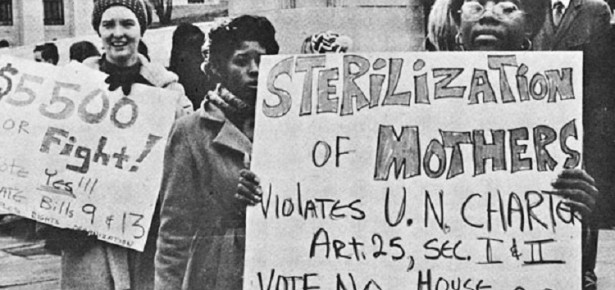
In the early 1940s, a Mrs. Hayes decided that her daughter, Velma, wasn’t worth the trouble. She committed her to Oregon’s Fairview Hospital and Training Center at Salem. Some fifteen years later, in 1957, a Mr. Morris decided that his 13-year old daughter Ruth required some education: taking the “Training Center” portion of the name literally, he committed his daughter to the same institution. Another decade and a half later, in 1973, two Alabama officials knocked on the door of Minnie Relf, an illiterate mother of three children and a Medicaid recipient. They told her that her daughter needed some shots.
All three women were sterilized by the state. They were among over 70,000 Americans coercively sterilized under state sterilization laws. The
original justification for the law was eugenic, meaning that the sterilizations were designed to ward off a decline in national intelligence through excessive fertility among the “feebleminded.” Velma and Ruth were sterilized under such laws. But sterilizations soon acquired other justifications: as a means of reducing welfare dependency (Minnie Relf) and as means to reduce world population growth (hence the strong role of eugenicists in US-based anti-population growth foundations).
All three campaigns – against feeblemindedness, welfare, and population growth – had similar characteristics. They were led by experts who made hysterical predictions about the social, economic, and environmental consequences of failing to sterilize. In all three cases, sterilization advocates argued, as so many have before and since, that the overwhelming imperative of decreased fertility and increased sterilization demanded a relaxation of human rights constraints. And all three campaigns disproportionately affected some of the world’s most vulnerable populations: the people with mental disabilities throughout the United States, African Americans in North Carolina, citizens of the developing world and the poor everywhere.
Sterilized by the State examines the stories of Velma Hayes, Ruth Morris, and dozens of other sterilization victims interviewed by the authors; it traces through multiple archives the policy history of eugenics, and it shows how eugenic sterilization increased in the United States after World War II and the Holocaust because wealthy and powerful people – those whose education, upbringing and resources made them the very opposite of those whom they wished to see sterilized – did everything they could to maintain and expand America’s sterilization laws.
About the Authors:
Randall Hansen is a Professor of Political Science at the University of Toronto. Desmond King is a Straus Fellow at NYU Law School in 2013-14. They are the authors of Sterilized by the State: Eugenics, Race and the Population Scare in Twentieth-Century North America.
Latest Comments
Have your say!